Understanding Supply and Demand Key to Profitable Forex Trading May 23, 2025

Thinking of Entering a Trade? Applying Strategies but Still Not Getting It Right?
Have you ever wondered why your trading account continues to bleed despite your best efforts? Trading is inherently challenging, and retail traders struggle to achieve consistent success. This article offers a fresh perspective on how to interpret market movements and use them to your advantage. By understanding the role of Banks and Financial Institutions (BFIs) and learning to identify Supply and Demand Zones, you can refine your strategy and hopefully be more profitable.
The Reality of Retail Traders
As retail traders, we may believe we are in control of our trades. We analyse charts, apply strategies, and execute buy or sell orders, with the aim of capitalising on market movements. However, the truth is that retail traders are not the ones moving the market. In fact, they contribute only 9% to the stock market and 5.5% to the Forex (FX) market.1 Our individual trades have minimal impact on price movements.
The real market movers are Banks and Financial Institutions (BFIs). These entities manage massive volumes of trade, often on behalf of large clients or to hedge their own portfolios. They are the primary source of market liquidity and create the significant price movements that we see on our charts. Retail traders are essentially reacting to their movements. And if we end up on the wrong side of the trade, our losses can be swift and severe.
Understanding the Forex Market
In this article, we will focus on the Forex market, the largest financial market in the world. According to the Bank for International Settlements (BIS), the daily trading volume in the Forex market exceeds US$7.7 trillion. 3 This massive liquidity along with low transaction costs and the availability of leverage, makes Forex an attractive market for retail traders.
In Forex, currencies are traded in pairs, such as EUR/USD or GBP/JPY. The first currency in the pair is known as the base currency, and the second is the quote currency. For example, in the EUR/USD pair, the Euro (EUR) is the base currency, and the US Dollar (USD) is the quote currency. When you click “buy” or “sell,” you are speculating on the movement of one currency relative to the other.
For example:
- If you buy EUR/USD, you’re expecting the Euro to strengthen against the US Dollar.
- If you sell EUR/USD, you’re expecting the US Dollar to strengthen against the Euro.
Supply and Demand Zones Created by BFIs
As mentioned earlier, BFIs are the primary drivers of price movements in the Forex market. They execute large orders gradually at specific price levels, and this repeated activity creates Supply and Demand Zones, which often trigger sharp price reactions. Retail traders who can identify these zones and the associated trading patterns, stand a better chance of riding the institutional wave, instead of being wiped out.
Identifying Supply and Demand Zones
Supply and Demand Zones are areas on the price chart where significant buying or selling pressure has previously caused the price to stall or reverse. They are typically characterised by sharp reversals when price revisits those areas. Here is how to identify them:
- Supply Zones: These are areas where the price has reversed downward after a rally. They indicate an excess of supply, which creates selling pressure and price movement downward.
- Demand Zones: These are areas where the price has reversed upward after a drop. They indicate an excess of demand, which creates buying pressure and price movement upwards.
For example, let us look at the USD/SGD pair on a 4-hour period. After a brief pause or consolidation, the price made a sharp move downward. By marking this area as a Supply Zone (Green box), we can anticipate that the price may reverse downward again if it retests this level.
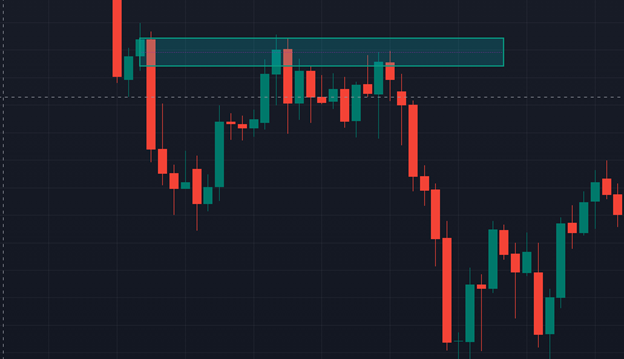 Source: TradingView
Source: TradingView
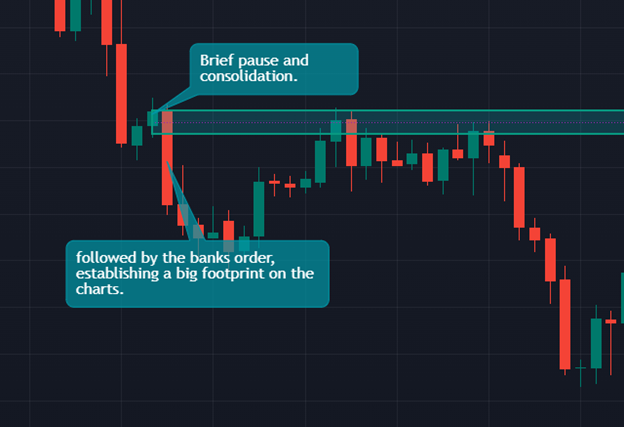 Source: TradingView
Source: TradingView
Similarly, in a Demand Zone, we can expect the price to reverse upward if it retests the level.
Trading Patterns in Supply and Demand
Once you’ve identified Supply and Demand Zones, the next step is to look for trading patterns that indicate whether the price is likely to reverse or continue in the same direction.
Retracement Patterns
1.Rally-Base-Drop (RBD): In this pattern, the price rallies upward, consolidates (forms a base), and then drops sharply. This indicates a potential reversal downward. As a trader, you will be waiting for price to retrace and retest the supply zone before opening a position.
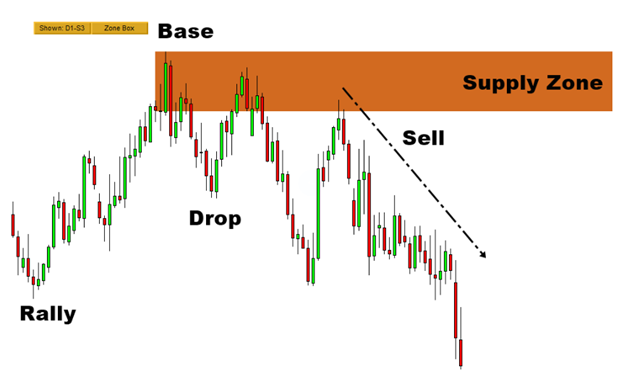 Rally-Base-DropSource: Algo Trading & Investment
Rally-Base-DropSource: Algo Trading & Investment
2.Drop-Base-Rally (DBR): In this pattern, the price drops, consolidates, and then rallies sharply. This indicates a potential reversal upward. As a trader, you would want to mark this area as a Demand Zone and anticipate a price reversal upwards if it retests the zone again.
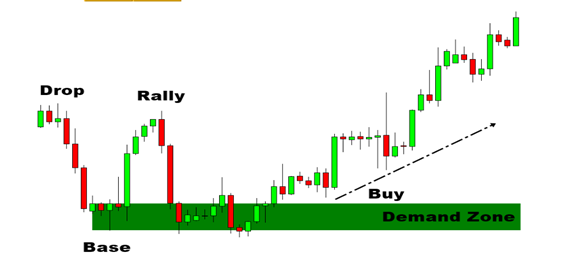 Drop-Base-RallySource: Algo Trading & Investment
Drop-Base-RallySource: Algo Trading & Investment
Continuation Patterns
3.Drop-Base-Drop (DBD): In this pattern, the price drops, consolidates, and then continues to drop further. This indicates a continuation of the downtrend. As a trader, you would mark this area as a Supply Zone and anticipate price continuation downwards if it retests this level.
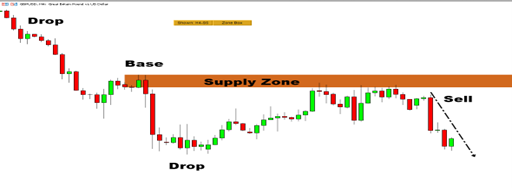 Drop-Base-DropSource: Algo Trading & Investment
Drop-Base-DropSource: Algo Trading & Investment
4.Rally-Base-Rally (RBR): In this pattern, the price rallies, consolidates, and then continues to rally further. This indicates a continuation of the uptrend. Traders can mark the consolidation point as a demand zone if the price retraces and test that price level again.
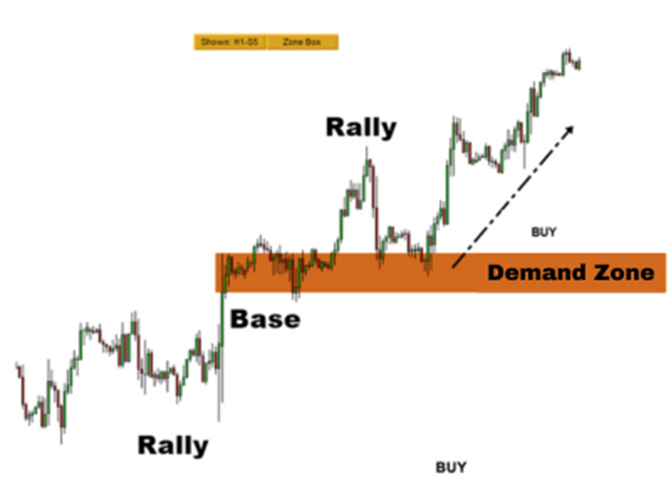 Rally-Base-RallySource: Algo Trading & Investment
Rally-Base-RallySource: Algo Trading & Investment
Using Pin Bars to Confirm Zones
One of the most reliable candlestick patterns for confirming Supply and Demand Zones is the Pin Bar. A Pin Bar is characterised by a long wick and a small body, indicating rejection of a certain price level.
 Source: DotnetTutorials
Source: DotnetTutorials
Here’s how to use Pin Bars in your trading strategy:
- Bullish Pin Bar: Indicates rejection of lower prices and a potential reversal upward.
- Bearish Pin Bar: Indicates rejection of higher prices and a potential reversal downward.
For example, in the GBP/JPY pair, we can see a Bullish Pin Bar forming in a Demand Zone. This confirms that the price is likely to reverse upward from this level.
 Source: TradingView
Source: TradingView
Risk Management: The Key to Survival
No trading strategy is complete without proper risk management. Even the best setups can fail. That is why robust risk management is non-negotiable. Here are two common methods to manage your risk:
- Percentage Risk: Risk only 1%-3% of your account balance per trade. For example, if your account balance is $10,000, you should risk no more than $100-$300 per trade.
- Fixed Dollar Amount: Determine a fixed dollar amount to risk per trade (e.g., $200) then calculate your position size based on your stop-loss level.
- [1] https://www.forex.academy/what-percentage-of-the-forex-market-is-retail-traders/
- [2] https://algotrading-investment.com/2022/07/14/supply-and-demand-analysis/
- [3] https://www.bis.org/statistics/rpfx22_fx.htm
- [4] https://dotnettutorials.net/lesson/pin-bar-trading-strategy/
For example, if you are willing to risk $100 per trade and your stop-loss is 20 pips, you can calculate your position size with this formula:
Position Size = (Dollar Risk ÷ Stop-Loss in Pips) × Pip Value
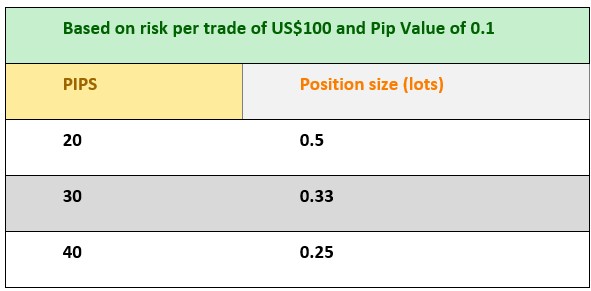 Source: TradingView
Source: TradingView
This helps you to avoid overtrading and risking too much of your account on a single trade.
Conclusion
Trading is a skill that requires continuous learning, practice, and discipline. By understanding the role of Banks and Financial Institutions (BFIs) and learning to identify Supply and Demand Zones, you can refine your strategy and improve your chances of success. Remember, the key to long-term profitability is not just having a good strategy but also managing your risk effectively. Take the time to practice these concepts, back test your strategies, and stay patient. With persistence and the right approach, you can turn your trading account into a profitable one.
How to get started with POEMS

POEMS’ award-winning suite of trading platforms offers investors and traders more than40,000 financial products across global exchanges.
Take this opportunity to expand your trading portfolio with our wide range of products including Stocks, CFDs, ETFs, Unit Trusts and more across 15 global exchanges available for you anytime and anywhere to elevate you as a better trader using our POEMS Mobile 3 App!
For enquiries, please email us at cfd@phillip.com.sg.
References:
Disclaimer
These commentaries are intended for general circulation and do not have regard to the specific investment objectives, financial situation and particular needs of any person. Accordingly, no warranty whatsoever is given and no liability whatsoever is accepted for any loss arising whether directly or indirectly as a result of any person acting based on this information. You should seek advice from a financial adviser regarding the suitability of any investment product(s) mentioned herein, taking into account your specific investment objectives, financial situation or particular needs, before making a commitment to invest in such products.
Opinions expressed in these commentaries are subject to change without notice. Investments are subject to investment risks including the possible loss of the principal amount invested. The value of units in any fund and the income from them may fall as well as rise. Past performance figures as well as any projection or forecast used in these commentaries are not necessarily indicative of future or likely performance.
Phillip Securities Pte Ltd (PSPL), its directors, connected persons or employees may from time to time have an interest in the financial instruments mentioned in these commentaries.
The information contained in these commentaries has been obtained from public sources which PSPL has no reason to believe are unreliable and any analysis, forecasts, projections, expectations and opinions (collectively the “Research”) contained in these commentaries are based on such information and are expressions of belief only. PSPL has not verified this information and no representation or warranty, express or implied, is made that such information or Research is accurate, complete or verified or should be relied upon as such. Any such information or Research contained in these commentaries are subject to change, and PSPL shall not have any responsibility to maintain the information or Research made available or to supply any corrections, updates or releases in connection therewith. In no event will PSPL be liable for any special, indirect, incidental or consequential damages which may be incurred from the use of the information or Research made available, even if it has been advised of the possibility of such damages. The companies and their employees mentioned in these commentaries cannot be held liable for any errors, inaccuracies and/or omissions howsoever caused. Any opinion or advice herein is made on a general basis and is subject to change without notice. The information provided in these commentaries may contain optimistic statements regarding future events or future financial performance of countries, markets or companies. You must make your own financial assessment of the relevance, accuracy and adequacy of the information provided in these commentaries.
Views and any strategies described in these commentaries may not be suitable for all investors. Opinions expressed herein may differ from the opinions expressed by other units of PSPL or its connected persons and associates. Any reference to or discussion of investment products or commodities in these commentaries is purely for illustrative purposes only and must not be construed as a recommendation, an offer or solicitation for the subscription, purchase or sale of the investment products or commodities mentioned.
This advertisement has not been reviewed by the Monetary Authority of Singapore.
CFD Disclaimer
This promotion is provided to you for general information only and does not constitute a recommendation, an offer or solicitation to buy or sell the investment product mentioned. It does not have any regard to your specific investment objectives, financial situation or any of your particular needs. Accordingly, no warranty whatsoever is given and no liability whatsoever is accepted for any loss arising whether directly or indirectly as a result of your acting based on this information.
Investments are subject to investment risks. The risk of loss in leveraged trading can be substantial. You may sustain losses in excess of your initial funds and may be called upon to deposit additional margin funds at short notice. If the required funds are not provided within the prescribed time, your positions may be liquidated. The resulting deficits in your account are subject to penalty charges. The value of investments denominated in foreign currencies may diminish or increase due to changes in the rates of exchange. You should also be aware of the commissions and finance costs involved in trading leveraged products. This product may not be suitable for clients whose investment objective is preservation of capital and/or whose risk tolerance is low. Clients are advised to understand the nature and risks involved in margin trading.
You may wish to obtain advice from a qualified financial adviser, pursuant to a separate engagement, before making a commitment to purchase any of the investment products mentioned herein. In the event that you choose not to obtain advice from a qualified financial adviser, you should assess and consider whether the investment product is suitable for you before proceeding to invest and we do not offer any advice in this regard unless mandated to do so by way of a separate engagement. You are advised to read the trading account Terms & Conditions and Risk Disclosure Statement (available online at https://www.poems.com.sg/) before trading in this product.
About the author
Zheng Wei Seow
Dealer
Contract for Differences
Zheng Wei graduated from RMIT university with a Bachelor's Degree in Economics and Finance. His interest is in FX and trading with strategies using a more hands-on approach as his trading style. There is always room for retail traders who love to grow on their own.

 Mastering Stop-Loss Placement: A Guide to Profitability in Forex Trading
Mastering Stop-Loss Placement: A Guide to Profitability in Forex Trading  Crude Realities: Understanding oil prices and how to trade them
Crude Realities: Understanding oil prices and how to trade them  Gold at All-Time Highs: What’s Fuelling the 2025 Rally?
Gold at All-Time Highs: What’s Fuelling the 2025 Rally?  Salesforce: A Steady Tech Leader in Volatile Times
Salesforce: A Steady Tech Leader in Volatile Times 




